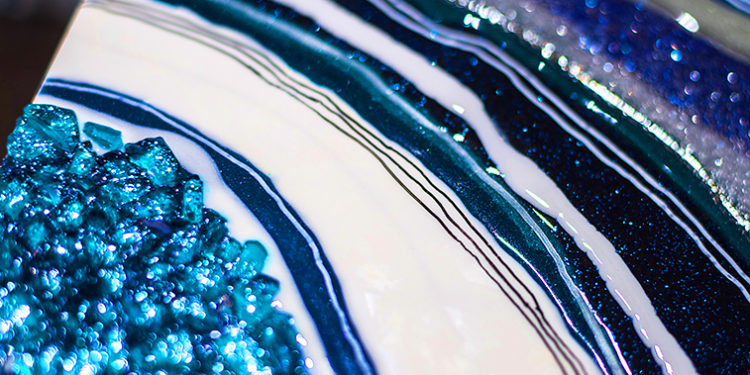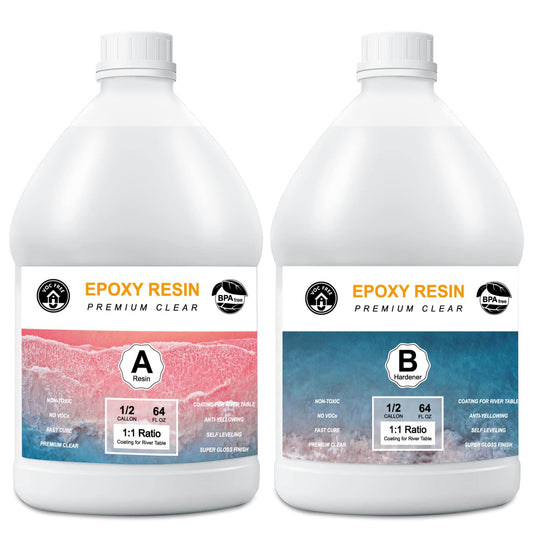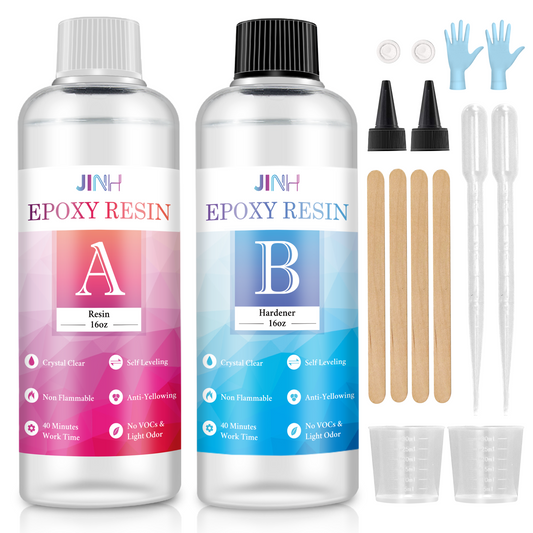Before Starting Your Project, Please Read complete Instruction.
FEATURES
- Working Time:30-50 minutes
- Mix Ratio: 1 to 1 by volume
- Demould Time:8-12 hours
- Fully Cure: 1-2 days
- Self-Levling & Self Degassing
- Anti-Yellowing
- Hard as Rock
NOTICE
- Working Area - Our optimum environment temperature range is 72-84°F in a clean environment. In this temperature range, you can demould between 8 and 12 hours, and its optimal work ability will be at 24 hours. At 24 hours it will sand and plane as easy as wood.
- Mixing Volume - Do not mix more than3 gallon at once time, because when A and B are mixed, heat will be generated, if over 3 gallon, too much heat will broke the epoxy resin.The warmer the air temperature, the less operation time you have and the quicker it will be cured.
- Coloring - We suggest only using epoxy resin color pigments, mica pigment powder, alcohol inks and dyes. Do not use any water base dyes or additives in the resin.Any dry filler can be added to the resin to achieve different appearances such as sand stone, granite, or other solid surfaces.6%is the limit of color that can be added before the curing process is affected.
- Surface Coverage - In order for resin to properly self-level and flow across surface, you must pour a generous amount of resin onto surface. For large surfaces, we recommend coating no more than 3 square feet at a time.
- Shelf Life - The shelf life is six months if storing at the cool and dry place temperature of under 72°Avoid from sunlight, high temperature or high humidity environment. It's recommended to use up as soon as possible when it was opened.
COATING INSTRUCTIONS
- Prepare the mixture of A & B to 1:1 rato (by volume not by weight)
- Slowly pour onto surface and allow the resin to naturally flow over entire surface.
3 It is necessary to coat all surfaces of the mold and objects to be embedded into resin to eliminate bubbles showing up while the resin cures.
- If the mold contains extremely small surface porosity, pouring a small amount of resin onto the surface and trowel or brush a thin coat onto the surface prior.
- Allow to cure for at least 12 hours. If desired, a second coat can be added in as little as 4-6 hours.
6.The operating environment should be ventilated and should keep away from fire. Closely sealed after use.
7.Coating Edges - To achieve coating of side walls of bar tops or tables,you may dam the edges with tape and pour the clear cast until it has completely self-leveled inside the dam. Then quickly remove the tape to allow even flow of the resin over the edge.
COMMON PROBLEM
- WHY DOES THE EPOXY RESIN STICKY AND NOT CURE
- Inaccurately Measured.
Measuring it properly means using graduated mixing cups to make sure you get accurate measurements 1:1 by volume (Not by weight) and measure the A and B resin kit separately with different measuring cups to prevent the different volume it may cause.
- Under-mixed
Please make sure you mix your resin thoroughly for at least 3 minutes. Make sure to scrape the sides and bottom of your mixing container as you stir.
- There is Residue in the Mixing Cup
If you reused the mixing cup, make sure clean it before using.
- Inclusions are Not Dry
If you want to add inclusions into resin, make sure inclusions completely dry.
- Room Temperature is Unsuitable
Epoxy is a sensitive product for time and temperature.Resin cures best in a room temperature of low 72-84°F. When the relative humidity is higher than 85%, the surface of the cured mixture will absorb moisture in the air, and form a layer of white mist in the surface, so when the relative humidity is higher than 85%, is not suitable for room temperature curing, it's suggested use the heat curing.
- Add Too Much Colorant or Pigment
Please do not add more than 12% of the total combined volume of resin and hardener (eg. 100ml resin + 50mlhardener = 150ml total would require no more than 18ml of colorant).
- CONSIDERING THAT YOUR PROJECT IS STILL STICKY
- Sand down any perfectly cured areas with coarse sand-paper, such as 80 grit. Wipe up any sanding residue with a damp paper towel.
- If you have areas with runny or gooey resin, you'll have to scrape off as much wet material, as best you can.
- Soft or sticky spots are a result of off ratio or inadequate mixing. Make sure you have measured the resin accurately by volume and equal parts. Then make sure to slowly mix the material thoroughly until absolutely no swirls can be seen. Most common mistake is under mixing
- Once you've scraped your piece down and your piece is clear of any sanding dust, then go ahead and pour a fresh coat of epoxy resin which was carefully measured and thoroughly mixed.
- BUBBLING PROBLEM
The formation of bubbles mainly occurs at process of mixing, or the epoxy resin reacts with the surface on which is coated, so you need to keep the surface clean and completely dry. Mix with a stick slowly, carefully and thoroughly by clockwise.
Meanwhile,There are some tips for minimizing the air bubbles.
After pouring each side into your mixing cup, then wait for 3 minutes to allow some of the air bubbles to rise to the surface. Once at the surface, take a stir stick and move the bubbles to the side of the cup and crush.
If you see tiny bubbles while the resin is still wet, you can use a torch or heat gun on low - 8 in from the surface to remove bubbles.(Do not attempt to heat the epoxy--it can catch fire.)
If you have a large air bubble, use a pin or needle to get the air out. Do this well before the resin starts to set or it can destroy the finish.
Use a drill to remove bubbles after the epoxy has hardened. Apply a second coat of resin to get a glassy, seamless finish.
- HOW TO REMOVE EPOXY PROBLEM
You could use Isopropyl Alcohol. Acetone or vinegar also works well.
Isopropyl Alcohol -just rub or soak the area of your hair with lsopropyl alcohol.
Vinegar - Put some vinegar on a cloth and, then soak the area with the epoxy. Once it begins to soften, apply abrasion and then wash with soap and water.
Acetone - It's the primary ingredient in nail polish remover and paint stripper. Use the same process as vinegar to remove epoxy from your skin or your hair.The acetone is flammable and should not be inhaled in large quantities. It's recommended to use this material only in well-ventilated rooms and not near open flames. After removal, it is best to wash the treated area thoroughly with soap and water and then apply a moisturizer, as acetone draws moisture from the skin.
Citrus-Based Waterless Cleaner - A citrus-based foam cleaner is a skin-friendly agent for removing epoxy and safer to use then acetone. Simply rub the cleaner onto the affected area, and then wash it off with water thoroughly.
Adhesive Remover - Cured or dried epoxy requires a harsh chemical in order to soften it up. There are a number of adhesive removers on the market with varying degrees of harshness. Only pursue this method when removing epoxy from surfaces, never from your skin.
MATERIAL SAFETY DATA SHEET
Product Name: Epoxy Resin And Hardener
Products Use:Art and Crafts, decoration, electronic components potting, coating,flooring, carbon fiber products
Mixture of the substances listed below with nonhazardous additions.
|
Composition of Epoxy Resin: |
|||
|
CAS: 25068-38-6 |
4,4'-Isopropylidenediphenol, oligomeric reaction products with 1- |
80-90% |
|
|
NLP: 500-033-5 |
chloro-2,3-epoxypropane |
|
|
|
Index number: 603-074-00-8 |
Aquatic Chronic 2, H411; H319; Skin Sens. 1, H317 |
Skin Irrit. 2, H315; Eye Irrit. 2, |
|
|
CAS: 100-51-6 |
Benzyl alcohol |
9-19% |
|
|
EINECS: 202-859-9 Index number: 603-057-00-5 |
Acute Tox. 4, H302; Acute Tox. 4, H332 |
|
|
|
CAS: 57834-33-0 |
ethyl 4-[[(methylphenylamino)methylene]amino]benzoate |
1% |
|
|
EINECS: 260-976-0 |
Acute Tox. 4, H302 |
|
|
|
Composition of Hardener: |
|||
|
CAS: 39423-51-3 |
Propylidynetrimethanol, propoxylated, reaction products with |
50-70% |
|
|
NLP: 500-105-6 |
ammonia |
|
|
|
|
Eye Dam. 1, H318; Aquatic Chronic 2, H411; 4, H302; Acute Tox. 4, H312 |
Acute Tox. |
|
|
CAS: 100-51-6 |
Benzyl alcohol |
29-49% |
|
|
EINECS: 202-859-9 Index number: 603-057-00-5 |
Acute Tox. 4, H302; Acute Tox. 4, H332 |
|
|
|
CAS: 57834-33-0 |
ethyl 4-[[(methylphenylamino)methylene]amino]benzoate |
1% |
|
|
EINECS: 260-976-0 |
Acute Tox. 4, H302 |
|
|
DESCRIPTION OF FIRST AID MEASURES
Immediately remove any clothing soiled by the product.
Symptoms of poisoning may even occur after several hours; therefore medical observation for at least 48 hours after the accident
After inhalation: Supply fresh air; consult doctor in case of complaints.
After skin contact: Immediately rinse with water.
After eye contact: Rinse opened eye for several minutes under running water. Then consult a doctor.
After swallowing: Call for a doctor immediately.
Most important symptoms and effects, both acute and delayed:
No further relevant information available.
Indication of any immediate medical attention and special treatment needed:
No further relevant information available.
ACCIDENTAL RELEASE MEASURES
Personal precautions, protective equipment and emergency procedures:
Wear protective equipment. Keep unprotected persons away.
ENVIRONMENTAL PRECAUTIONS:
Do not allow product to reach sewage system or any water sourse.
Inform respective authorities in case of seepage into water course or sewage system. Dilute with plenty of water.
Do not allow to enter sewers/ surface or ground water.
Methods and material for containment and cleaning up:
Absorb with liquid-binding material (sand, diatomite, acid binders, universal binders, sawdust). Use neutralising agent.
Dispose contaminated material as waste
HANDLING AND STORAGE
Precautions for safe handling:
Information about fire - and explosion protection: No special measures required.
Conditions for safe storage, including any incompatibilities
- Requirements to be met by storerooms and receptacles: No special requirements.
- Information about storage in one common storage facility: Not required.
- Further information about storage conditions: Keep container tightly sealed.
CUSTOMER SERVICE
lf you have any questions or concerns, please contact us via Amazon chat.Our After-sale service team are always online and try best to solve every customer’s problem.




